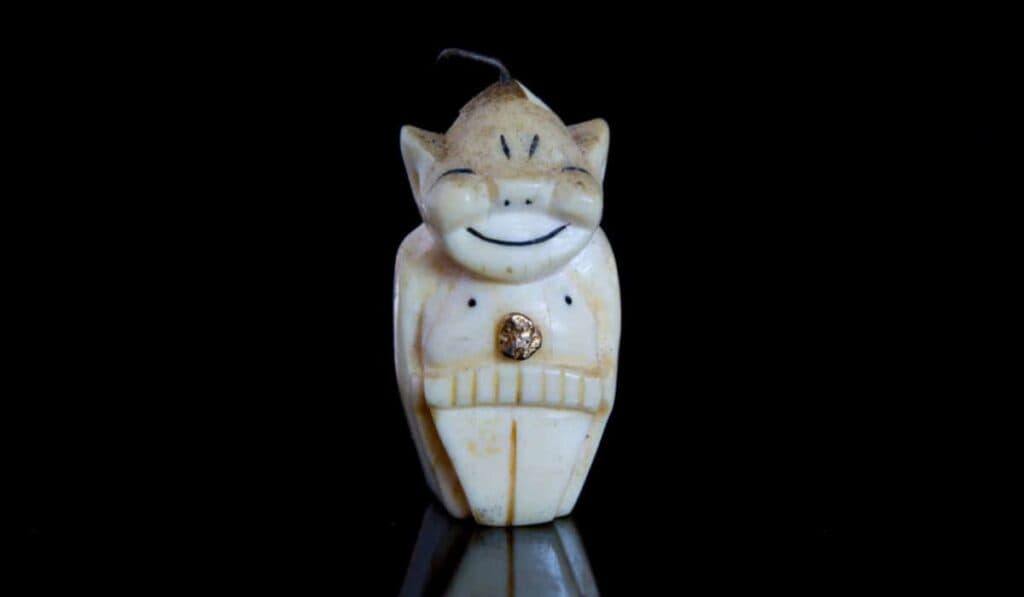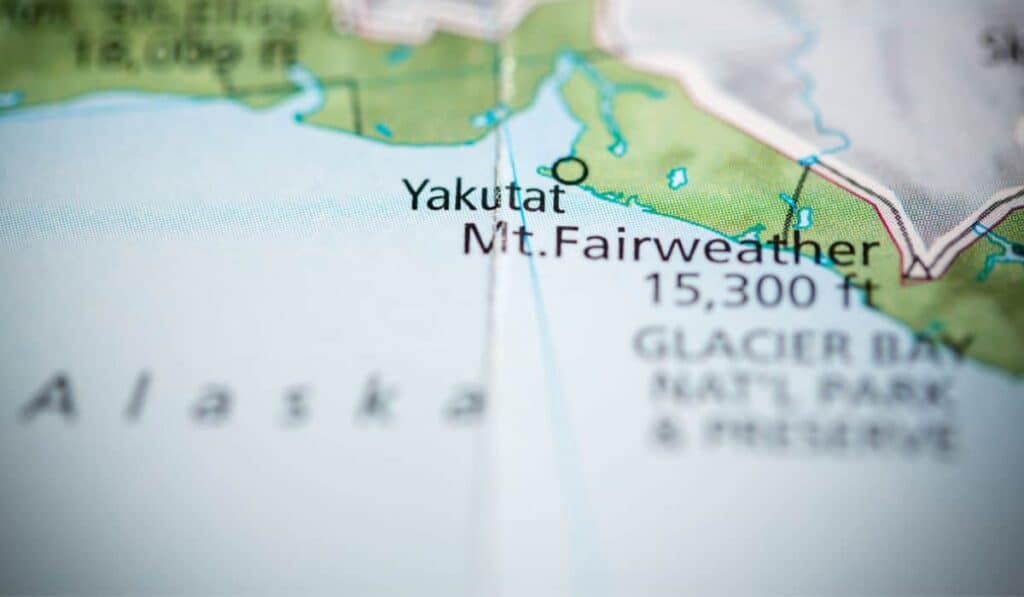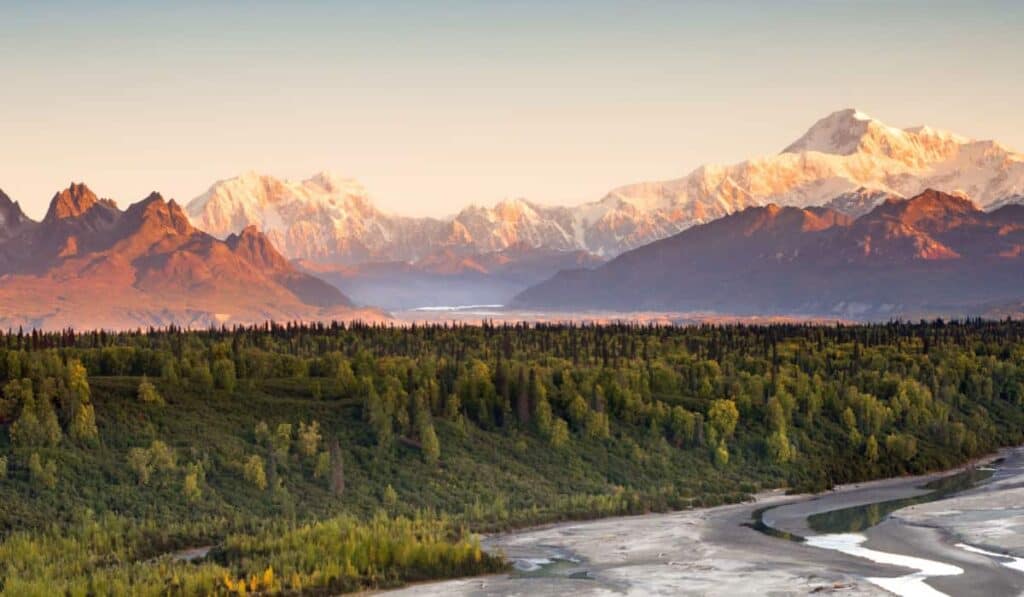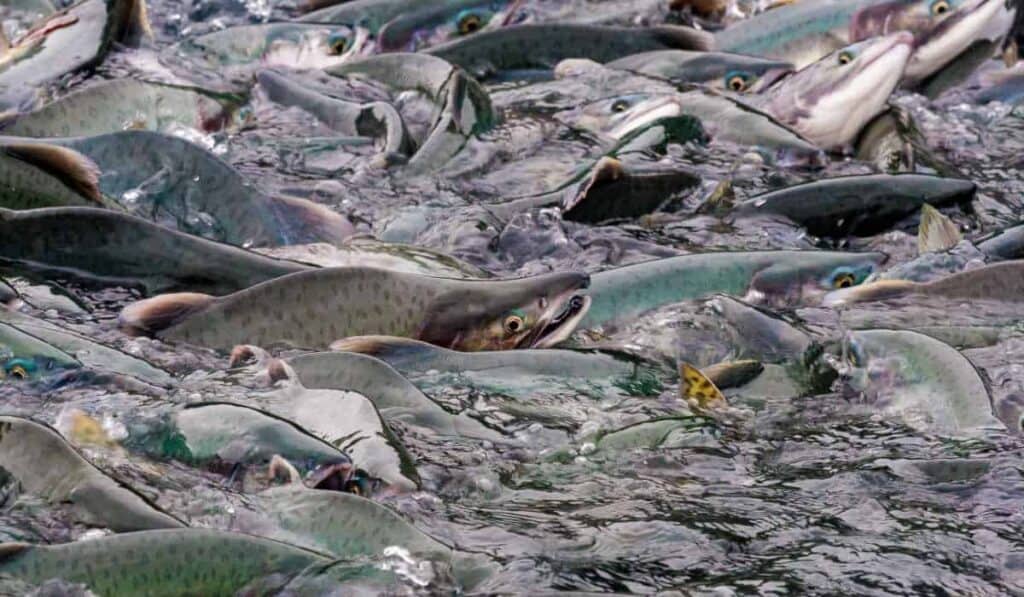Alaskans, like people everywhere in the world, use certain words or phrases that only make sense to people who know what they mean.
However, if you’re looking to move to Alaska or travel there you’ll probably want to read up on a few of these phrases so you don’t seem like a cheechako.
While you’re unlikely to hear all of these if you’re just on an Alaska cruise, you can still use your newfound knowledge of these uniquely Alaskan slang terms or phrases to impress your friends and family!
13 Common Alaskan Slang Terms
1. Termination Dust

Termination Dust is an Alaskan term that refers to the first snowfall visible on top of a mountain, which is seen as a sign that winter is coming.
In Earth’s atmosphere, it gets colder the higher up you are (like that scene at the end of the first Iron Man movie). That’s why snow appears on the mountaintops well before it gets cold enough to snow on the ground.
It gets its name from the fact that construction workers and other seasonal workers who see it know that it means their jobs will soon be terminated for the winter.
There is a slight disagreement as to what qualifies as termination dust. Some people believe the snow has to reach a certain level on the mountain, while others argue that the very first snow is all that matters.
A local climatologist told news outlet KTOO recently that he believes that termination dust must be visible from town, it has to be lower than 4,000 feet, and it must last at least half of one day.
Regardless of the preferred definition, Alaskans who see snow on the mountaintops know that winter is on its way, meaning it’s time to prepare.
2. Billiken

A Billiken is a small doll or trinket that is designed to give good luck. Receiving one as a gift means even better luck.
It is referred to as “The God of the Way Things Ought To Be” and they often appear as keychains, jewelry, or small dolls, among other forms.
The concept was actually created by a schoolteacher from Kansas City who moved to Canada. St. Louis University uses a Billiken as its mascot.
They were popularized in Nome in the early 1900s, then spread to Anchorage and were all over the place by the 1960s.
They often come with poems or short stories, like the common one: “Rub his tummy, tickle his toes, good luck follows wherever he goes. As a blues chaser, he’s a honey, for good luck, just rub his tummy.”
They can easily be found in gift shops all over the state. I’m not sure what the success rate is, but it can’t hurt, right?
3. Sourdough
A “Sourdough” is someone who has lived in Alaska long enough to know how to survive a harsh winter.
The term comes from the Klondike Gold Rush, where prospectors would often sleep holding their sourdough bread jars to keep them warm and avoid ruining their food.
There is no exact definition or requirement to become a Sourdough. Some say five years, some say ten, and others would argue that it can take a lifetime.
For many Alaskans, though, it is considered more of a state of mind than a strict number of years.
People who come from cold climates may become Sourdoughs more quickly than those from warmer climates, as they already know what freezing temperatures and snow can mean, for example.
4. Cheechako
A Cheechako is the opposite of a Sourdough, someone who has just arrived in Alaska and does not understand what it means to be an Alaskan or how to handle the cold.
The term comes from the Chinook Native Americans of the Pacific Northwest and means “newcomer.”
Just like Sourdoughs, it is also more of a state of mind. I’ve known Cheechakos who have lived here for years.
Their pipes often freeze in winter because they’ve never had to deal with that before coming to Alaska. Alaskans know to run the bathroom tap on a slow drip to prevent that from happening.
They also tend to spend long periods of time talking about the city or state they used to live. Not to insult anyone from that state, but many Cheechakos are former Californians who think and expect Alaska to be more like their previous home.
Most Alaskans don’t have an issue with Cheechakos. We’re more concerned for their safety and their abilities to navigate a bad winter.
5. Alpenglow

Alpenglow isn’t uniquely Alaskan, but it does create one of the most beautiful lighting effects you’ll ever see. For me, it’s a close second only to the Northern Lights.
It refers to a reddish hue in the sky that can be seen after sunrise or before sunset. When the sun goes below the horizon and behind a mountain, sunlight is reflected off of particles or other objects in the lower atmosphere, giving everything a red glow.
The term comes from the German word Alpenglühen which literally translates as “The Alps Glow,” since the phenomenon is very common over there. It can happen anywhere that has a lot of mountains.
I just thought it was a beautiful sunset until I sent a picture to a friend. She replied, “That’s alpenglow, silly!” and explained to me what it was. Well, everyone has to learn things sometimes, I suppose.
I can’t stress enough how beautiful it is. The picture above will give you some idea, but it’s something that has to be seen in order to fully be appreciated.
It can happen at any time of the year, too, so you’ll have a good chance to see it no matter when you come up.
6. Snowbird
A snowbird is a person whose primary residence is Alaska or Canada but has a second home down south they use in the winter, typically in Florida, Arizona, Hawaii, or another sunny state.
They are called this because their travel patterns mirror those of birds that fly south for the winter.
Snowbirds are typically senior citizens who have retired, but not always. I know people in their 30s who work seasonal jobs up in Alaska, then go back to visit their relatives in Florida during the winter.
This allows them the best of both worlds. They get to enjoy Alaska’s moderate summer climate, then avoid the harsh winters by going to a place with a moderate winter climate.
They get to experience Juneau, for example, in the summer with 60 or 70-degree weather, without the zero-degree winters.
Then, they can go to Phoenix or Scottsdale, for example, and enjoy a 60 or 70-degree winter, without experiencing 110+ degrees in the summer.
The term is not one of disrespect. Many Alaskans are jealous of snowbirds and will often plan vacations in the winter, particularly over winter break for those with children still in school.
7. Snow Machine

A Snow Machine is a vehicle that is used to travel over snow that allows you to reach areas that aren’t accessible by road or by walking.
They are typically designed for only one person at a time, although older models and some of the newer ones have two seats. They have a windshield, but generally no doors or top.
The term “snowmobile” is not used in Alaska. I don’t really understand the difference or the importance of the distinction, but you can expect to be corrected if you don’t say “snow machine.”
Snowmachining is a common sporting event that involves two or more people competing in races while riding snowmobiles.
Snow machine accidents are unfortunately common, just like every kind of vehicle. I know a few people who have been seriously injured when their snow machines flipped while they were riding up north.
I say “up north” because that’s where they’re most commonly used. There are some communities in the interior (I’ll explain that term in a little bit) that are only accessible by snow machine or plane.
They don’t get much use in Juneau because we have a lot of roads and people who do have them only use them recreationally.
8. Permafrost

Permafrost is a layer of ice that coats the ground that is found in large portions of northern Alaska.
15% of the Northern Hemisphere and 11% of the world are covered in permafrost, with Alaska making up a decent portion of that amount.
To qualify as permafrost, it must be soil, rock, or sediment that is completely frozen over (i.e., remained below 32 degrees Fahrenheit) for two or more years.
That doesn’t mean the temperature outside is below 32 degrees every minute of every day, though. In some places, it’s a remnant of cold temperatures from the last ice age.
I’ve never gone hunting up north, but I’ve heard from a lot of people that they’ll bring beer or other drinks with them and just set them on the ground because the permafrost keeps them cold.
The permafrost layer is slowly melting, however, as a result of increasing global temperatures, which has led to landslides, erosion, and other issues.

That melting is responsible for carbon emissions, but experts believe that it’s not enough to have a major impact on global climates.
In the Interior, permafrost is broken up into smaller segments, but as you go further north, it’s more of a continuous layer.
9. The “Interior”

I’ve mentioned it quite a few times, so it’s time to explain what Alaskans mean when we talk about “The Interior.”
The Interior refers to the middle section of the Alaska mainland, roughly bordered by two mountain ranges: the Brooks Range in the north and the Alaska Range in the south.
The Interior consists of 175,000 square miles and has a population of about 113,000. Of those, about one-quarter (or 32,000 people) live in Fairbanks, Alaska’s second-largest city (although it only beats Juneau by a couple of hundred people).
Many people live in small villages, often referred to as “The Alaskan Bush,” although it is not to be confused with “Alaskan Bush People,” an awful show that is widely hated in our state.
The Athabaskans are the largest group of Alaska Natives who live in the Interior, although Fairbanks does have sizable populations of Iñupiat and Yupik Native Alaskans.
Speaking of Alaskan words, I’ll throw out here that the term “Eskimo” probably isn’t one you should use here. These groups do not use the term to refer to themselves and many consider it offensive.
If you don’t know the name of the specific group, “Alaska Native” or “Native Alaskans” will do just fine.
10. Permanent Dividend Fund
The Permanent Fund Dividend (PFD) is a payment issued to qualifying Alaskans every October that represents the people’s share of the oil revenue from drilling on the North Slope.
It began in the early 80s as just a few hundred dollars, but these days, the amount is generally between $1,000 and $2,000 a year, although 2022’s will be slightly higher.
For many Alaskans living in bush communities who live a subsistence lifestyle of hunting and fishing for food, this may be the only money they receive in the entire year.
There has been a fierce debate in Alaska over how the PFD money should be distributed. When the price of oil was lower a few years back, dividends were caught in order to fund government programs.
One side believes that the money belongs to the people and the government should follow the state law that governs the formula for determining that year’s payout.
The other side believes that funding government programs, like education and children’s healthcare, is more important.
Most Alaskans who have lived here for over a year qualify for the money, provided they have not been convicted of a felony. The money can also be garnished to pay certain debts, like back child support, unpaid University of Alaska debts, or other reasons.
They are also required to state their intent to continue living in Alaska indefinitely, although many people have been known to move in October immediately after receiving that year’s PFD.
11. “Going Outside”
“Going Outside” is a term that is used, most commonly in Southcentral Alaska near Anchorage and the Interior, to (usually jokingly) refer to any place outside of Alaska, typically another state, although it could be anywhere.
For example, a man about to take his family on a vacation to see relatives in Alabama might tell his boss, “I’ll need a week or two off next month; my family and I are Going Outside to visit family.”
Sometimes the word “outside” is used by itself to refer to somewhere down south, as in, “Beth was born Outside and only moved here a few years ago but she has now become a Sourdough.”
The term comes from a related term used by Northern Canadians that refers to Southern Canada.
It is important to note that the opposite phrase is almost never used. Alaskans never refer to Alaska as “inside.”
It is not often used in Southeast Alaska, at least in my experience. Down here, you’ll often hear more common expressions for the continental US like “the lower 48” or “down south.” I’m pretty sure I’ve used both of those multiple times in this very article.
12. Breakup

I’m not talking about the kind of breakup you’d hear about in a country music song. In Alaska, the term means something different (although we do still use breakup in the traditional sense, of course).
In some parts of Alaska, breakup refers to a specific period between winter and summer. It doesn’t just mean “spring,” because it still snows in the spring in Alaska.
One of the first signs is that the layers of ice on top of the rivers (which will be brought up again in the next entry) begin to break up, hence the name.
In many ways, it’s the opposite of Termination Dust. It means that summer is coming soon and it’s time to prepare for fishing season.
In the cities, you’ll see the snow on the ground begin to melt. The massive parking lot at Tikhatnu Commons over on Muldoon looks like the Caspian Sea until the water eventually drains down into the sewers.
When Breakup hits, it’s time to put the skis and snowboards back into storage and get the fishing equipment ready.
You’ll have to change the studded tires on your vehicle to the non-studded variety and remove your truck chains or face a fine from the government.
13. Ice Road

Our final term here is “Ice Road,” which fans of the television show “Ice Road Truckers” may already know. This is one of the only Alaska-based reality shows that people here actually like, by the way.
As the name suggests, an ice road is a manmade route that allows you to get between two places by driving over particularly thick ice.
Some communities can only be reached in the winter by using ice roads, but they also have other uses.
Oil drilling companies, for example, use a lot of ice roads in order to avoid damaging the fragile tundra between drilling sites.
Constructing these roads can be very difficult because you need to make sure the ice is thick enough to drive over in a heavy vehicle.
The Department of Natural Resources has a list of guidelines that must be followed before an ice road can be constructed, with minimum temperatures and levels of snow on the ground that must be met to ensure the safety and stability of the road.
They are actually quite safe if built properly as they will have a minimum of one foot of solid ice below the surface. That said, I’ve never been on one and I don’t plan on changing that anytime soon.
Final Thoughts
These are just some of the many expressions that you might hear in Alaska and you might not have heard before.
Some of these, like Billiken, you’ll probably hear at least one (or in that specific case, see one) if you come up on a cruise.
Others, like termination dust, you might not hear unless you live here or happen to be in Alaska on the exact day it shows up.
Now that you’re familiar with these terms, you can use them to impress your Alaskan friends or jump-start your knowledge on your way to becoming a real Alaskan Sourdough!







